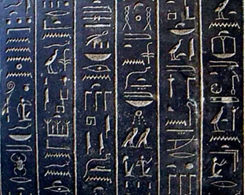
How Reading Works
HOW DO GOOD READERS READ?
It is likely that you yourself never learned to read well. You don’t need to take a reading test to determine this. If you find yourself relying heavily on a variety of “strategies” to determine what the words on the page might be, then you are almost certainly not proficient.
Here the primary “strategies” that teachers tell children to use:
- memorizing lists of written words
- searching for “clues” in pictures (when pictures are present)
- guessing what sort of word might fit here (e.g. noun or verb)
- using the existing context to guess what the following words might be;
- as a last resort, looking at the initial letter of a word to determine its starting sound.
If you rely mainly on these methods then you’re the victim of a failed educational system that is probably going to fail your children as well.
In constrast, good readers decode the words they are reading, which means that they determine how each word is pronounced based on its spelling. They read well because decoding is very accurate. Readers who decode can almost always determine the correct words even if they’ve never seen the words before. If the pronunciation resulting from decoding does not immediately match the pronunciation of a known word then there are only a few possible alternate pronunciations to try, and the reader might resort to the above strategies to finally determine a pronunciation that matches a known word.
The phonetic reader uses the above strategies only as a last resort to choose from a small handful of possible pronunciations that are evident from the decoding process, with a very high chance of perfect accuracy. Further, the decoding reader cannot possibly choose a word that is outside the realm of those few possible pronunciations that the decoding process allows. In contrast, the non-phonetic reader uses these strategies as a first resort to guess what the word might be from all the words in the language, and consequently has no practical limit to the number of possible wrong guesses.
To summarize:
- The successful reader:
- decodes the words of a sentence, usually producing the correct word, or sometimes just a few possible pronunciations for each word;
- then if needed uses the “strategies” for deciding which of the few possibilities for each uncertain word is the correct one. Because the spelling dictates the very few pronunciations that are possible, the reader almost always succeeds in identifying all words of a sentence within seconds.
- decodes the words of a sentence, usually producing the correct word, or sometimes just a few possible pronunciations for each word;
- The functional illiterate:
- uses the various “strategies” to guess what each non-memorized word might be from among the hundreds of thousands of possibilities;
- is unlikely to recognize many words in unfamiliar written material even if the reader knows the words verbally, since the number of artificially memorized written words can never even remotely approach the reader's verbal vocabulary;
- is unlikely to comprehend what the sentences mean, since the meaning of an entire sentence can be dramatically changed by the mis-identification of even a single word.
- uses the various “strategies” to guess what each non-memorized word might be from among the hundreds of thousands of possibilities;
Stone Age Reading
Until about 2,000 BC, every written language was essentially a set of pictures.
Arguably, people remained in the Stone Age for countless millennia because they could not accurately transmit their ideas to their children. Pictures like these do not convey much information:
- In order to “read” images you must memorize all of the images you might encounter. There might be hundreds of thousands of words or ideas, each one associated with a cryptic image.
- If you encounter one that you haven’t memorized then you must look for clues in its picture.
- If that fails then you must use the context to guess what the icon might mean.
- Failing all that, you might guess what the remainder of the text might be based on the part you’ve already read.
Modern Reading
Humans emerged from the Stone Age because they developed a new way of writing down ideas. The new method was to encode the sounds that people make when speaking. In other words, the written symbols (i.e. letters) represent sounds rather than ideas.
This was an incredibly clever development. It is arguably the most clever idea in all of human history, since our modern world could not have come into existence without it. You only need a few dozen symbols to represent all the sounds of a language, as opposed to hundreds of thousands of symbols to represent all the ideas that people might have.
This concept is called “phonics.” Here’s an example of how it works. If you want to represent a cat, you don’t create an icon that looks like a cat. Instead you write letters representing the sounds that people make when they say the word “cat”:
c | a | t |
makes the initial hard sound | makes the middle soft sound | makes the final hard sound |
So when you read the word “cat” you are not recalling some idea that you memorized; rather you are making the sounds represented by the letters. It is as though you are a tape recorder playing back a tape. The whole concept of phonetic reading is essentially the same as tape recording, all imagined four thousand years before electronics and modern tape recording machines came into existence.
The genius is in the accuracy and density of information that alphabetic words can store. A child who memorizes about seventy “rules” of phonics can almost perfectly decode (i.e. read) almost all of the English language, which contains about 400,000 words. The same rules apply to short words, long words, simple ideas and complex ideas. So by memorizing a mere 70 phonics rules, a child can decode an unlimited number of words with reasonable accuracy. Without those rules the child has 400,000 English words to memorize (or more likely guess).
Here is how a phonetic reader decodes and understands words:
- The reader makes the sound of the word, just as if someone had spoken it.
- The reader hears the word (either literally if reading aloud or mentally if reading silently), just as if someone had spoken it.
- The reader understands the text just as if someone had spoken it.
Arguments Against Phonics
The practitioners of stone-age reading ideology have many arguments when battling parents who want their children to become modern (i.e. phonetic) readers. Here are some of them:
English isn’t phonetic
The argument is that English is not phonetic (i.e. doesn’t have a set of rules allowing for decoding) and therefore decoding isn’t even possible, or at least it is not reliable.
English is not perfectly phonetic. It has a lot of exceptions to the phonetic rules and these exceptions must be memorized. A lot of the exceptions are in high frequency words that people use all the time, and so even early readers must deal with them. But even with its many exceptions, English is remarkably easy to decode using phonetic rules. Even a child can decode a word using the rules, determine that there is no word pronounced that way, and easily determine the correct word from the very few possibilities that the spelling suggests. This leaves the child with just a few possible options when deducing what an irregular word (or a word with several possible pronunciations) might be, rather than thousands or tens of thousands of possibilities from which non-phonetic readers must often guess.
The fact that six-year-olds can be trained to decode and comprehend relatively complex English sentences is a total refutation of this argument, and further it says something about the mentality of whoever is making the argument (“I believe what I believe, regardless of easily reproducible evidence to the contrary.”).Decoders are “word callers” who don’t understand what they’re reading
The idea here is that phonetic readers are simply calling out words without understanding what they mean. There is some truth to this claim if you are teaching a child poorly. It is possible that your student is struggling with decoding so much that he or she doesn’t have any remaining mental capacity for comprehending the text. This means that the student is working too hard because you are advancing too quickly. The remedy is to slow down and review previous material until the child can decode the material fluently without stress.
Reading instruction typically starts around age six. A typical six-year-old has a 10,000 word vocabulary. When reading phonetically, he or she is hearing the sentences as if they had been spoken. If you are teaching at a pace that is appropriate for that child, the decoding process is not a struggle that consumes the child’s entire mental capacity. If the child is hearing (either literally or mentally) the same sentence as if someone had spoken it, then that child will understand all sentences composed entirely of words that are in his/her verbal vocabulary. If the child is reading material with words so unfamiliar that he/she would not understand the same sentences if spoken, then the child is obviously reading inappropriate material.
But the reality is even more the opposite of what this argument suggests. If I am reading a textbook containing material that is new to me, then a rational book will explain new terms as they are introduced. A well-written textbook will introduce the word “transistor” using other words that I presumably already know. As a phonetic reader I can also now pronounce the word “transistor.” Since I can pronounce it, I can now talk to people using that word, even though I have never used the word verbally before. The non-phonetic reader, in contrast, does not know how to pronounce the word and so cannot use the word in conversation until some speaking person makes the connection for him.
Every child has a unique “learning style” to which we must cater
The idea is that while phonics might work for some kids, most other kids will do better with alternatives. The problem is that alphabetic languages are intentionally designed to work well only when read alphabetically (i.e. phonetically); that is the whole point of writing letters rather than pictures. The accuracy of alphabetic languages exists only because our symbols (letters) encode sounds rather than whole ideas.
We might similarly say that young automobile drivers have different learning styles, and therefore we shouldn’t bother teaching most of them how to use the steering wheel or the gas pedal. The whole concept seems less preposterous when discussing reading only because most people have never spent much time thinking about how alphabetic languages work.
Teaching phonics is rote and boring; authentic reading is more engaging
Here is a quote from the article Hard Words, regarding an elementary school teacher:
She ditched the phonics workbooks and the decodable readers. “And once I started teaching in a more whole way, a more encompassing way of the whole child — What does this child need? What does that child need? Let’s read more real books,” she explained, “my teaching improved, the students learned more. I feel they came out the other side much better.” She admitted she had no evidence her students were learning more, but she said they seemed more engaged.
The teacher’s standard of success is whether the kids are more engaged when reading a story book (or more likely when the teacher reads them the story book), presumably replete with pictures that essentially tell the whole story. Children can memorize pictures while having the story read to them. Later when turning the book’s pages the child can recite back the memorized story without having any concept of why there are printed words on the page. In fact in Whole Language classrooms such behavior is encouraged and celebrated. The whole idea of accurately interpreting the words on the page is dismissed as unnecessary and dogmatic.
We could use this same logic to teach algebra using a graphing calculator that pictorially solves all the problems for the child, or to teach music by merely playing simple songs (no scales, arpeggios, music theory, etc.). Everything will seem wonderful in the classroom and the child will be more easily engaged than if he/she had been learning the necessarily rote rudiments of the subject. But when the child enters the real world, which is full of books with few or no pictures and no accompanying teacher to provide “clues,” it will become obvious that the real world has nothing to do with his/her classroom experience.


